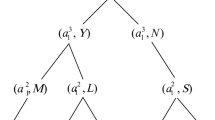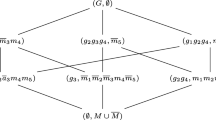Abstract
Three-way decision (3WD) theory and granular computing have recently received much attention as methods for thinking and problem solving. Based on the trisecting-and-acting model in the 3WD, this paper proposes two trisecting-and-learning models for rule induction, which begin with a constructed concept space and a search for the most suitable level of granularity in high-to-low and low-to-high manners, respectively. The learning results are sets of granules that can induce raw rules. By combining the advantages of granular computing and the trisecting-and-acting method, the models only need to process one or two parts of the trisecting result, simplifying the calculation. An interval-valued rule-inducing algorithm is proposed to obtain more general rules from raw rules. It coarsens the granularity further by merging the granules through the maximal adjacent relation of the learned granules. The interval-valued rules are obtained at the same time. The models in the paper are compatible with incomplete mixed data containing numeric, symbolic, do not care, and lost types. Symbolic data are converted into numeric types by considering their semantic order. This type of conversion enables intervals to be generated from symbolic data, producing more general rules. The rationality for allowing rules with missing data is also considered in this paper. Comparative analysis with existing works and experiments reveals the improvements of our models. Although there are a small fraction of incomplete rules and fewer intervalized rules on numeric data, the rules we induce have a higher coverage ratio and a much larger intervalized ratio for symbolic data. Moreover, our model induces simpler rules for all types of datasets.








Similar content being viewed by others
Data Availability
The datasets generated during and/or analysed during the current study are available in the UCI Machine Learning repository, https://archive.ics.uci.edu/ml/datasets.php.
References
Shah A, Azam N, Ali B, Khan MT, Yao JT (2021) A three-way clustering approach for novelty detection. Inf Sci 569:650–668
Dua D, Graff C (2019) UCI Machine Learning Repository [Http://archive.ics.uci.edu/ml]. irvine, CA: University of california school of information and computer science
Liang DC, Fu YY, Xu ZS (2022) Three-way group consensus decision based on hierarchical social network consisting of decision makers and participants. Inf Sci 585:289–312
Liu D (2021) The effectiveness of three-way classification with interpretable perspective. Inf Sci 567:237–255
Hao F, Yang YX, Min GY, Loia V (2021) Incremental construction of three-way concept lattice for knowledge discovery in social networks. Inf Sci 578:257–280
Lang GM, Yao YY (2021) New measures of alliance and conflict for three-way conflict analysis. Int J Approx Reason 132:49– 69
Lang GM (2021) Three-way conflict analysis: alliance, conflict, and neutrality reducts of three-valued situation tables. Cogn Comput. https://doi.org/10.1007/s12559-021-09905-x
Lang GM (2020) A general conflict analysis model based on three-way decision. Int J Mach Learn Cyb 11:1083–1094
Lang GM, Miao DQ, Fujita H (2020) Three-way group conflict analysis based on pythagorean fuzzy set theory. IEEE T Fuzzy Syst 28(3):447–461
Lang GM, Luo JF (2020) Three-way conflict analysis: a unification of models based on rough sets and formal concept analysis. Knowl-Based Syst 194:105556
Fujita H, Gaeta A, Loia V, Orciuoli F (2019) Resilience analysis of critical infrastructures: a cognitive approach based on granular computing. IEEE T Cybern 49(5):1835–1848
Ju HR, Ding WP, Yang XB, Fujita H, Xu SP (2021) Robust supervised rough granular description model with the principle of justifiable granularity. Appl Soft Comput 110:107612
Yu H, Chen LY, Yao JT (2021) A three-way density peak clustering method based on evidence theory. Knowl-Based Syst 211:106532
Furnkranz J, Gamberger D, Lavrac N (2012) Foundations of Rule Learning. Springer, Berlin
Luo JF, Hu MJ, Lang GM, Yang X, Qin KY (2022) Three-way conflict analysis based on alliance and conflict functions. Inf Sci 594:322–359
Yang JL, Yao YY (2022) A model of three-way approximation of intuitionistic fuzzy sets. Int J Mach Learn Cyb 13:163–174
Niu JJ, Chen DG, Li JH, Wang H (2022) dynamic rule-based classification model via granular computing. A Inf Sci 584:325–341
Grzymala-Busse JW (2010) A local version of the MLEM2 algorithm for rule induction. Fund Inform 100:1–18
Grzymala-Busse JW (2002) MLEM2: a new algorithm for rule induction from imperfect data. In: Proceedings of the 9th international conference on information processing and management of uncertainty in knowledge-based systems, pp 243–250
Zhou J, Pedrycz W, Gao C, Lai ZH, Yue XD (2021) Principles for constructing three-way approximations of fuzzy sets: a comparative evaluation based on unsupervised learning. Fuzzy Set Syst 413:74–98
Zadeh LA (1979) Fuzzy sets and information granularity, Biochem. Biophys Res Commun 91:498–501
Hu MJ (2021) Three-way Bayesian confirmation in classifications. Cogn Comput
Clark PG, Gao C, Grzymala-Busse JW, Mroczek T (2018) Characteristic sets and generalized maximal consistent blocks in mining incomplet data. Inf Sci 453:66–79
Liu Q, Chen Y, Zhang GQ, Wang GY (2021) A novel functional network based on three-way decision for link prediction in signed social networks. Cogn Comput
Shen QP, Zhang QH, Zhao F, Wang GY (2022) Adaptive three-way C-Means clustering based on the cognition of distance stability. Cogn Comput 14:563–580
Susmaga R (1997) Analyzing discretizations of continuous attributes given a monotonic discrimination function. Intell Data Anal 1:157–179
Xu WH, Yu JH (2017) A novel approach to information fusion in multi-source datasets: a granular computing viewpoint. Inf Sci 378:410–423
Yang X, Li YJ, Li QK, Liu D, Li TR (2022) Temporal-spatial three-way granular computing for dynamic text sentiment classification. Inf Sci 596:551–566
Yang X, Zhang YY, Fujita H, Liu D, Li TR (2020) Local temporal-spatial multi-granularity learning for sequential three-way granular computing. Inf Sci 541:75–97
Zhang XP, Li JH, Li WK (2022) A new mechanism of rule acquisition based on covering rough sets. Appl Intell. https://doi.org/10.1007/s10489-021-03067-x
Yao YY, Yang JL (2022) Granular rough sets and granular shadowed sets: three-way approximations in Pawlak approximation spaces. Int J Approx Reason 142:231–247
Yao YY (2018) Three-way decision and granular computing. Int J Approx Reason 103:107–123
Yao YY (2016) Three-way decisions cognitive computing. Cogn Comput 8:543–554
Yao YY (2010) Three-way decisions with probabilistic rough sets. Inf Sci 180:341–353
Yao YY (2022) Symbols-meaning-value (SMV) space as a basis for a conceptual model of data science. Int J Approx Reason 144:113–128
Pawlak Z (1991) Rough Sets: Theoretical Aspects of Reasoning About Data. Kluwer Academic Publishers, Dordrecht
Pawlak Z (1982) Rough sets. Int J Comput Inf Sci 11:341–356
Funding
This work was supported by the National Natural Science Foundation of China (NO. 62172048) and China Scholarship Council (NO. 202006470014).
Author information
Authors and Affiliations
Corresponding author
Ethics declarations
Ethics approval
This article does not contain any studies with human participants or animals performed by the author.
Conflict of Interests
The authors have no relevant financial or non-financial interests to disclose.
Additional information
Publisher’s note
Springer Nature remains neutral with regard to jurisdictional claims in published maps and institutional affiliations.
Appendix A: Tables of experimental data
Appendix A: Tables of experimental data
Rights and permissions
Springer Nature or its licensor (e.g. a society or other partner) holds exclusive rights to this article under a publishing agreement with the author(s) or other rightsholder(s); author self-archiving of the accepted manuscript version of this article is solely governed by the terms of such publishing agreement and applicable law.
About this article
Cite this article
Chen, Y., Zhu, P., Li, Q. et al. Granularity-driven trisecting-and-learning models for interval-valued rule induction. Appl Intell 53, 19685–19707 (2023). https://doi.org/10.1007/s10489-023-04468-w
Accepted:
Published:
Issue Date:
DOI: https://doi.org/10.1007/s10489-023-04468-w




